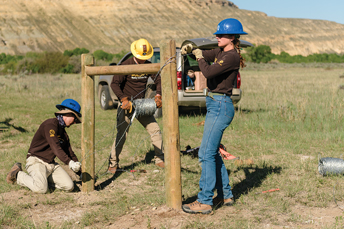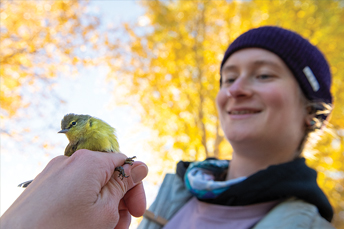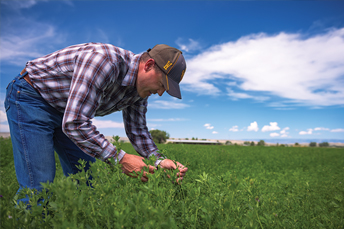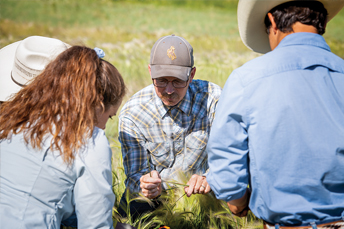
Contact Us
Institutional Communications
Bureau of Mines Building, Room 137
Laramie, WY 82071
Phone: (307) 766-2929
Email: cbaldwin@uwyo.edu
Thriving Lands

Wyoming Conservation Corps members Keith Johnson, Chad Browning and Sophie Bove
work on a buffalo fencing project in coordination with the Eastern Shoshone Tribe.
From agriculture to conservation, UW programs support land management efforts across the state.
By Micaela Myers
Wyoming Conservation Corps
Franklin D. Roosevelt established the Civilian Conservation Corps in 1933, enlisting young people in work programs to improve America’s public lands, forests and parks. Since 2006, the Wyoming Conservation Corps has partnered with the AmeriCorps national service program to connect students to natural resource and environmental experiences while promoting leadership. The nonprofit corps is located within the Haub School of Environment and Natural Resources — one of the few corps in the country to be located within a university — allowing it to offer academic credit to participants who also earn a living stipend. In addition, participants can earn industry-leading certificates in wilderness first responder, S-212 chainsaw, first aid, leave no trace and others.
“We partner with state, federal and local agencies and nonprofits to accomplish tasks that are conservation based,” says Interim Director Tyler Carroll. “A lot of the work we do is trail maintenance, removal of trees and habitat restoration.”
Approximately 50 crew members, including crew leaders, work throughout Wyoming all summer long, and crew groups include an all-women’s group, a veterans trail crew and traditional coed crews. The shoulder seasons of spring and fall are used to write grants and proposals, recruit, partner and educate. The program is an important resource for land managers and agencies in Wyoming that may not have the manpower or funding to conduct this work otherwise.
“All the work we do is designed for the residents of Wyoming and its visitors,” Carroll says. “Recreation is such an important part of our economy in the state, and that’s what we’re focused on.”
Wyoming Bird Initiative for Resilience and Diversity
Birds are not just for bird watching — they play an essential role in our ecosystem. They reduce pests, pollinate plants, spread seeds and much more. However, since 1970, we’ve lost more than a quarter of our bird population in the U.S. and Canada. This makes ornithology, the study of birds, all the more important. To increase hands-on student opportunities in this field, Corey Tarwater, an associate professor in the Department of Zoology and Physiology, and fellow faculty working on bird research at UW launched WYOBIRD (Wyoming Bird Initiative for Resilience and Diversity). WYOBIRD aims to advance knowledge, appreciation and conservation of birds locally and globally. The initiative achieves this by conducting novel research on birds, training a new generation of scientists at UW through hands-on training, and sharing science through networking, public outreach and seminar speakers.
“WYOBIRD is an exciting new initiative because it benefits our students both through hands-on experiences and development of new skills. It also creates a greater sense of community among our students and faculty,” says Tarwater, the Robert B. Berry Distinguished Chair in Ecology and director of WYOBIRD.

Graduate student Erin Stewart takes part in a bird banding project west of Laramie
as part of WYOBIRD’s field program.
A key aim of the initiative is to provide UW undergraduate and graduate students with direct experiences in the field of ornithology. Traditional coursework often lacks a field component where students can develop marketable skills that will prepare them for graduate school or employment, Tarwater says.
For example, students involved in WYOBIRD had the opportunity to lead and assist with projects in Albany County, including tree swallow nest box monitoring during the summer and a migration bird banding station this past fall. Students gained experience with field techniques, including bird banding and nest checks, fieldwork logistics and data management. Additionally, UW graduate students practice their teaching and communication skills, as they are responsible for hiring, training and supervising UW undergraduate students. Some undergraduate students are supported by “avian internships.”
“While at the university, gaining experience in the field I want to pursue makes my UW experience so much better,” says Howarth White, a UW junior from Rawlins majoring in wildlife and fisheries biology and management. “Working on projects like this makes me want my degree all that much more.”
Dr. Kurt S. Bucholz Irrigation Science Excellence Fund
In early 2023, the Gretchen Swanson Family Foundation announced a gift to UW in honor of rancher, large-animal veterinarian and legislator Kurt Bucholz. The gift supports ethical water rights management and hydrology research in Wyoming and the West.
“Kurt would have been so excited and supportive of this program,” says Laura Bucholz, president of the Gretchen Swanson Family Foundation and surviving spouse of Kurt Bucholz. “Water was so important to him, and I think this will have a lasting impact across the state.”
The major gift from the Gretchen Swanson Family Foundation supports the Dr. Kurt S. Bucholz Irrigation Science Excellence Fund, which fosters excellence and provides financial support to the Department of Ecosystem Science and Management. A majority of this gift benefited from state matching dollars, and so the impact of this fund will be even larger.
Bucholz was a well-known Saratoga rancher, veterinarian and Carbon County legislator who was involved in water administration and supply concerns facing the Upper North Platte River Basin. He was the founding member of the Upper North Platte Water Users’ Association and served as president of its board for eight years. In 2002, he was elected to the Wyoming House of Representatives. He died in 2006.
The Bucholz ranch is nestled in the valleys of southern Wyoming among a patchwork of many large ranches whose survival rests on the precious amount of water they can use to irrigate their crops. With help from UW researchers and administrators, as well as those in the Legislature, members of this sprawling community are not only learning more effective methods for water management — they also are paving the way for complex conflict resolution across Wyoming and other drought-prone areas throughout the American West.
The Brush Creek Watershed Project is a model program for irrigation science, technology, management and conflict resolution within the state and beyond. This shared project of UW and the ranching community advances cooperative and effective administration of water rights among ranchers and other users of the watershed. It has allowed the Brush Creek water rights to move from paper to a real-world digital model. The Watershed Hydrology Graduate Assistantship, also established by the Gretchen Swanson Family Foundation, is a vital part of the Brush Creek project.

Extension Educator Jeremiah Vardiman studies alfalfa to find varieties resistant
to the alfalfa weevil at the Powell Research and Extension Center.
Research and Extension Centers
The UW College of Agriculture, Life Sciences and Natural Resources operates four research and extension centers in the state that conduct applied research, extension and outreach activities.
“The concept of having research in different parts of the state goes all the way back to 1891 when the agriculture experiment stations were started,” says Brian Mealor, director of the Sheridan Research and Extension Center. “The geographic diversity across the state means different weather, soils and crops.”
The centers can absorb more risk than local farmers and ranchers, trying new technologies, approaches and crops to evaluate them in a local setting and then sharing that knowledge. Residents approach personnel with needs and questions, and the centers host workshops on areas of interest. UW students also play an active role at the centers. Here’s a brief overview of some current activities at each of the centers.
The Sheridan Research and Extension Center supports both dryland agricultural research at its original 300-acre site near Wyarno and irrigated land at the 400-acre Adams Ranch. One of the center’s focus areas is evaluating and improving plant materials, such as edible beans, field peas and popping beans; forage crops such as sunn hemp, perennial warm and cool season grasses; and native plants for wildlife habitat and restoration. The center is also a site for studying invasive grasses in cooperation with the IMAGINE program.
At 7,220 feet above sea level, the Laramie Research and Extension Center is located at the highest elevation of all land-grant university research stations in the U.S., says Director Scott Lake. As such, it emphasizes high-elevation research in cattle and sheep. Facilities include the Cliff and Martha Hansen Teaching Arena and the 5,500-acre McGuire Ranch. Current cattle nutrition projects look at how diet may help combat brisket disease and the impact of microbiomes on production systems. In 2023, the center and the Department of Animal Science partnered to launch UW’s inaugural High Altitude Bull Test and Sale. Using GrowSafe boxes, it continues to advance feed efficiency research in sheep as well. The center also runs an annual ram test and the Wyoming Wool Initiative.
The 220-acre Powell Research and Extension Center focuses on irrigated row crop research, including barley, corn, sugar beet and dry bean producers, says Director Jim Heitholt. “Our stakeholders seek information about variety performance, fertility, irrigation and weed management, and we have projects addressing each of those needs.” The researchers also collaborate with campus partners. For example, they’re working with the Department of Family and Consumer Sciences to investigate new lines of popping beans. The center works closely with Powell’s UW Seed Analysis Lab and the Wyoming Seed Certification Service.
The James C. Hageman Sustainable Agriculture Research and Extension Center near Lingle comprises 1,522 acres of dry cropland, 349 acres of irrigated cropland, 1,880 acres of rangeland, 19 acres of irrigated organic cropland, 40 acres of dry land organic cropland, a feedlot and a livestock research laboratory. It offers research opportunities in rain-fed and irrigated cropland as well as grazing and confinement livestock systems. The center also offers an annual bull test. Other areas of research include grass and legume forage production, weed management in irrigated cropping systems and forage-based crop rotation studies, according to Director Steve Paisley. The center is also developing a cooperative precision agriculture program with Eastern Wyoming College.

IMAGINE Director Brian Mealor works with students at the Sheridan Research and
Extension Center.
Institute for Managing Annual Grasses Invading Natural Ecosystems
Native to the Mediterranean, cheatgrass was introduced to the Denver area in the late 1800s. This highly invasive species now infests more than 101 million acres in Western states, pushing out native perennial grasses that are better for livestock and wildlife. Recognizing the need to control these invasions, Gov. Mark Gordon announced an invasive species initiative in 2019, and the University of Wyoming responded by launching the Institute for Managing Annual Grasses Invading Natural Ecosystems (IMAGINE) in 2021 after extensive stakeholder feedback.
IMAGINE focuses on engaged research that directly impacts land management. Since its launch, IMAGINE has conducted 12 research projects, 20-plus presentations and three peer-reviewed publications in collaboration with the Wyoming Game and Fish Department, the U.S. Department of Agriculture and other partners. A $500,000 gift from the Joe and Arlene Watt Foundation helps support IMAGINE.
“Cheatgrass affects just about anyone dealing with wildlife habitat or livestock and rangeland ecosystems,” says IMAGINE Director Brian Mealor. “These invasive grasses create reduced forage quality and quantity for wildlife and livestock. They can also increase fire risk, and they can change the way the soil ecosystem works. In the most extreme cases, they can change the nature of the ecosystem to where animals that depend on those ecosystems no longer have what they need to survive and thrive.”
Each summer, a team of UW students helps IMAGINE collect data, and the center works with cooperative programs across the state. The IMAGINE team is also working with national partners to help give landowners the tools and knowledge to make effective management decisions.
The team found that focusing on restoring sites in danger of degradation and expanding out from there is more effective than focusing on highly damaged areas. The applied research also looks at best management methods such as herbicides to target geminating seedlings and various grazing strategies.
Mealor is not just an expert on this issue — it’s something that impacts him personally, as his family farms in the state. “Seeing the negative impacts that invasive plants have on the natural ecosystems in Wyoming and the West is very stark and striking,” he says. “If our team can help reduce those impacts and conserve the natural systems, that’s very important to me.”
Contact Us
Institutional Communications
Bureau of Mines Building, Room 137
Laramie, WY 82071
Phone: (307) 766-2929
Email: cbaldwin@uwyo.edu


